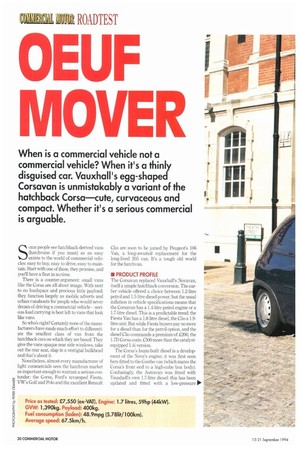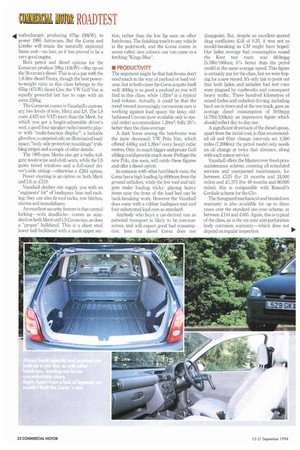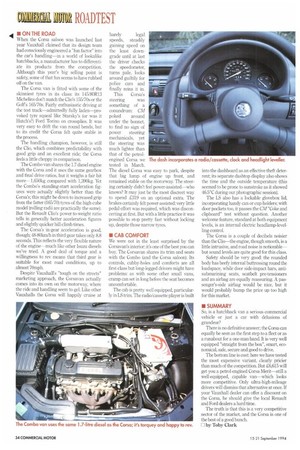OEU F S ome people see hatchback-derived vans (hatchvans if you must)
Page 32

Page 34

Page 36

If you've noticed an error in this article please click here to report it so we can fix it.
as an easy entree to the world of commercial vehicles: easy to buy, easy to drive, easy to maintain. Start with one of these, they promise, and you'll have a fleet in no time.
There is a counter-argument: small vans like the Corsa are all about image. With next to no loadspace and precious little payload. they function largely as mobile adverts and urban runabouts for people who would never dream of driving a commercial vehicle—serious load carrying is best left to vans that look like vans.
So who's right? Certainly none of the manufacturers have made much effort to differentiate the smallest class of van from the hatchback cars on which they are based. They give the vans opaque rear side windows, take out the rear seat, slap in a vestigial bulkhead and that's about it.
Nonetheless, almost every manufacturer of light commercials sees the hatchvan market as important enough to warrant a serious contender: the Corsa, Ford's revamped Fiesta, VW's Golf and Polo and the excellent Renault Clio are soon to be joined by Peugeot's 106 Van, a long-awaited replacement for the long-lived 205 van. It's a tough old world for the hatchvan.
The Corsavan replaced Vauxhall's Novavan, itself a simple hatchback conversion. The earlier vehicle offered a choice between 1.2-litre petrol and 1.5-litre diesel power; but the usual inflation in vehicle specifications means that the Corsavan has a 1.4-litre petrol engine or a 1.7-litre diesel. This is a predictable trend: the Fiesta Van has a 1.8-litre diesel, the Clio a 1.9litre unit. But while Fiesta buyers pay no more for a diesel than for the petrol option, and the diesel Clio commands a premium of £200, the 1.7D Corsa costs £500 more than the catalystequipped 1.4i version.
The Corsa's lsuzu-built diesel is a development of the Nova's engine; it was first seen here fitted to the Combo van (which mates the Corsa's front end to a high-cube box body). Confusingly, the Astravan was fitted with Vauxhall's own 1.7-litre diesel: this has been updated and fitted with a low-pressure turbocharger, producing 67hp (50kW), to power 1995 Astravans. But the Corsa and Combo will retain the naturally aspirated Isuzu unit—no loss, as it has proved to be a very good engine.
Both petrol and diesel options for the Corsavan produce 59hp (44kW)-9hp up on the Novavan's diesel. This is on a par with the 1.8-litre diesel Fiesta, though the hest powerto-weight ratio in this class belongs to the 65hp (47kW) diesel Clio; the VW Golf Van is equally powerful but has to cope with an extra 250kg.
The Corsavan comes in Vauxhall's customary two levels of trim, Merit and LS. The LS costs £435 (ex-VAT) more than the Merit, for which you get a height-adjustable driver's seat; a good four-speaker radio/cassette player with "multi-function display"; a lockable glovebox; a carpeted cab; an illuminated loadspace; "body side protection mouldings" (rubbing strips) and a couple of other derails.
The 1995-spec Merits also get a radio, tailgate wash/wipe and cloth seats, while the LS gains tinted windows and a full-sized driver's-side airbag—otherwise a £264 option.
Power steering is an option on both Merit and LS, at £319.
Vauxhall dealers can supply you with an "engineers' kit" of loadspace bins and racking; they can also fit roof racks, tow hitches, alarms and immobilisers.
An excellent security feature is that central
locking—with deadlocks comes as standard on both Merit and LS Corsavans, as does a "proper" bulkhead. This is a sheet steel lower half-bulkhead with a mesh upper sec
tion, rather than the low lip seen on other hatchvans. The finishing touch to any vehicle is the paintwork, and the Corsa comes in seven rather nice colours: our van came in a fetching "Kings Blue".
• PRODUCTIVITY
The argument might be that hatchvans don't need much in the way of payload or load volume, but in both cases the Corsa acquits itself well: 400kg is as good a payload as you will find in this class, while 1.02m3 is a typical load volume. Actually, it could be that the trend toward increasingly curvaceous cars is working against load space: the boxy, oldfashioned Unovan (now available only to special order) accommodates I .20m3; fully 20% better than the class average.
A dark horse among the hatchvans was the (now deceased) VW Polo Van, which offered 440kg and 1.26e (very boxy) cubic metres. Only its much bigger and pricier Golf sibling could provide much more. Perhaps the new Polo, due soon, will outdo these figures and offer a diesel option.
In common with other hatchback vans, the Corsa has a high loading lip (690min from the ground unladen), while the low roof and tailgate make loading tricky; placing heavy items near the front of the load bed can be back-breaking work. However the Vauxhall does come with a rubber loadspace mat and four substantial load eyes as standard.
Anybody who buys a car-derived van as personal transport is likely to be cost-conscious, and will expect good fuel consumption: here the diesel Corsa does not disappoint. But, despite an excellent quoted drag coefficient (Cd) of 0.35, it was not as mould-breaking as CM might have hoped. Our laden average fuel consumption round the Kent test route was 48.9mpg (5.781it/100Iun), 6% better than the petrol model at the same average speed. This figure is certainly par for the class, but we were hoping for a new record. It's only fair to point out that both laden and unladen fuel test runs were plagued by roadworks and consequent heavy traffic. Three hundred kilometres of mixed (laden and unladen) driving, including hard use in town and at the test track, gave an average diesel consumption of 59.0mpg (4.791it/100km); an impressive figure which should reflect day-to-day use.
A significant drawback of the diesel option, apart from the initial cost, is that recommended oil and filter change intervals are 4,500 miles (7,200km); the petrol model only needs an oil change at twice that distance, along with each minor service.
Vauxhall offers the Mastercover fixed-price maintenance scheme, covering all scheduled services and unexpected maintenance, for between £525 (for 24 months and 24,000 miles) and £1.375 (for 48 months and 60,000 miles); this is comparable with Renault's Cordiale scheme for the Clio.
The Sureguard mechanical and breakdown warranty is also available for up to three years over the standard one-year scheme, at between £144 and £465. Again, this is typical of the class, as is the six-year anti-perforation body corrosion warranty—which does not depend on regular inspection. When the Corsa saloon was launched last year Vauxhall claimed that its design team had consciously engineered a "fun factor'' into the car's handling—in a world of lookalike hatchbacks, a manufacturer has to differentiate its products from the competition. Although this year's big selling point is safety, some of that fun seems to have rubbed off on the van.
The Corsa van is fitted with some of the skinniest tyres in its class: its 145/80R13 Michelins don't match the Clio's 155/70s or the Golfs 165/70s. Fairly enthusiastic driving at the test track—admittedly fully laden—provoked tyre squeal like Starsky's (or was it Hutch's?) Ford Torino on crossplies. It was very easy to drift the van round bends, but to its credit the Corsa felt quite stable in the process.
The handling champion, however, is still the Clio, which combines predictability with good grip and an excellent ride; the Corsa feels a little choppy in comparison.
The Combo van shares the 1.7 diesel engine with the Corsa and it uses the same gearbox and final drive ratios, but it weighs a fair bit more-1,650kg compared with 1,390kg. Yet the Combo's standing-start acceleration figures were actually slightly better than the Corsa's; this might be down to increased grip from the fatter (165/70) tyres of the high-cube model (rolling radii are practically the same). But the Renault Clio's power-to-weight ratio tells in generally better acceleration figures and slightly quicker hill-climb times.
The Corsa's in-gear acceleration is good, though; 48-801unih in third gear takes only 8.8 seconds. This reflects the very flexible nature of the engine—much like other Isuzu diesels we've tried. A good deal of torque and a willingness to rev means that third gear is suitable for most road conditions, up to almost 70mph.
Despite Vauxhall's "tough on the streets" marketing approach, the Corsavan actually comes into its own on the motorway, where the ride and handling seem to gel. Like other Vauxhalls the Corsa will happily cruise at barely legal speeds, steadily gaining speed on the least downgrade until at last the driver checks the speedometer. turns pale, looks around guiltily for police cars and finally reins it in.
This Corsa's
steering was something of a conundrum: CM poked around under the bonnet, to find no sign of power steering mechanicals, yet the steering was much lighter than that of the petrolengined Corsa we tested in March. The diesel Corsa was easy to park, despite that big lump of engine up front, and remained stable on the motorway. The steering certainly didn't feel power-assisted—who knows? It may just be the most discreet way to spend £319 on an optional extra. The brakes certainly felt power-assisted: very little pedal effort was required, which was disconcerting at first. But with a little practice it was possible to stop pretty fast without locking up, despite those narrow tyres.
• CAB COMFORT We were not in the least surprised by the Corsavan's interior: it's one of the best you can buy. The Corsavan shares its trim and seats with the Combo (and the Corsa saloon). Its controls, cubby-holes and comforts are all first-class but long-legged drivers might have problems: as with some other small vans, cramp can set in long before the seat becomes uncomfortable.
The cab is pretty well equipped, particularly in LS trim. The radio/cassette player is built into the dashboard as an effective theft deterrent; its separate dashtop display also shows the time and the outside temperature (this seemed to be prone to sunstroke as it showed 46.5°C during our photographic session).
The LS also has a lockable glovebox lid, incorporating handy can or cup-holders; with door pockets too, it passes the CM "Coke and clipboard" test without question. Another welcome feature, standard at both equipment levels, is an internal electric headlamp-levelling control.
The Corsa is a couple of decibels noisier than the Clio—the engine, though smooth, is a little intrusive, and road noise is noticeable— but sound levels are quite good for this class.
Safety should be very good: the rounded body has beefy internal buttressing round the loadspace, while door side-impact bars, antisubmarining seats, seatbelt pre-tensioners and an airbag are equally reassuring. A passenger's-side airbag would be nice, but it would probably bump the price up too high for this market.
• SUMMARY So, is a hatchback van a serious commercial vehicle or just a car with delusions of grandeur?
There is no definitive answer; the Corsa can equally be seen as the first step to a fleet or as a runabout for a one-man band. It is very well equipped "straight from the box", smart, economical, safe, secure and good to drive.
The bottom line is cost: here we have tested the most expensive variant, clearly pricier than much of the competition. But £6,615 will get you a petrol-engined Corsa Merit—still a well-equipped, capable van—which looks more competitive. Only ultra-high-mileage drivers will dismiss that alternative at once. If your Vauxhall dealer can offer a discount on the Corsa, he should give the local Renault and Ford dealers a hard time.
The truth is that this is a very competitive sector of the market, and the Coma is one of the best of a good bunch.
El by Toby Clark
































































































